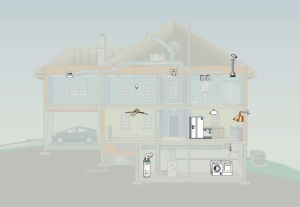Energy Efficient Lighting
Learn what your home needs to achieve ENERGY STAR labeling and how lighting can help.
By Susan Bloom
What you need to know:
- American homes consume 40% of all electricity
- ENERGY STAR provides path to achieving high standard of energy efficiency
- The ENERGY STAR mark provides third-party ID of the home as energy efficient
- Methods include high-efficiency technologies such as lighting
- More than 1 million ENERGY STAR homes built to date

ENERGY STAR qualified lighting, appliances and fans can be found throughout an ENERGY STAR home, helping to reduce monthly utility bills, while providing high-quality performance. Image by Environmental Protection Agency
Fact: In 2011, residences nationwide consumed nearly 40% of all of the electricity sold by utilities, and at an ever increasing cost per kilowatt-hour. Opportunities abound for American homes to improve their energy efficiency. One way to meet this challenge is to pursue energy-efficient improvements to an existing home, while another is to pursue an ENERGY STAR label for new construction.
The U.S. Environmental Protection Agency’s bright blue ENERGY STAR label is a government-backed symbol of energy efficiency. When earned by a home, the label signifies that it was constructed using energy-efficient products and practices that help to reduce energy consumption and costs for residents, protect the environment, and promote a more energy-independent America.
How to Earn ENERGY STAR
To earn an elite residential ENERGY STAR designation, your home must meet strict guidelines for energy efficiency, measuring at least 15% more energy-efficient than homes built to the 2004 International Residential Code (IRC) and 20-30% more efficient than standard homes.
You can achieve these goals through the combined use of energy-efficient products such as high-performing insulation and windows, efficient heating and cooling equipment, and ENERGY STAR qualified lighting and appliances. Homes built to ENERGY STAR specifications involve continuous oversight by a Home Energy Rater to ensure that the builder selects the optimal combination of energy-efficient products and features to meet or exceed ENERGY STAR standards.
Lighting Your Way to Energy Efficiency
Lighting represents 12% of the energy use in a home, making the use of energy-efficient lighting technologies one of the easiest ways to elevate your home’s efficiency. Compact fluorescent lamps, LEDs and high-efficiency luminaires (light fixtures) are all recognized by the ENERGY STAR program. They provide a broad range of comfortable, high-performing lighting options to help elevate your home’s efficiency profile and qualify for certification.
Homes that earn the prestigious label deliver many value-added benefits to homeowners and the community, from providing better protection against cold, heat, drafts, moisture, pollution and noise, to reducing greenhouse gas emissions and saving hundreds of dollars annually on electricity bills. ENERGY STAR homes also deliver homeowners the peace of mind associated with being built to exacting environmental standards and can often sell both at a premium and faster than standard homes.
Is an ENERGY STAR-certified home right for you? Since the program launched in 1995, more than 8,500 home builders have partnered with the EPA to construct more than 1 million ENERGY STAR qualified homes, saving American homeowners $1.2 billion on their energy bills and reducing greenhouse gas emissions by 22 billion pounds. For more information on ENERGY STAR Home eligibility, labeling requirements and procedures, and the more than 50 types of ENERGY STAR-certified products readily available in the market, as well as financial incentives and rebates that may be available to ENERGY STAR builders and homeowners by state, click here.